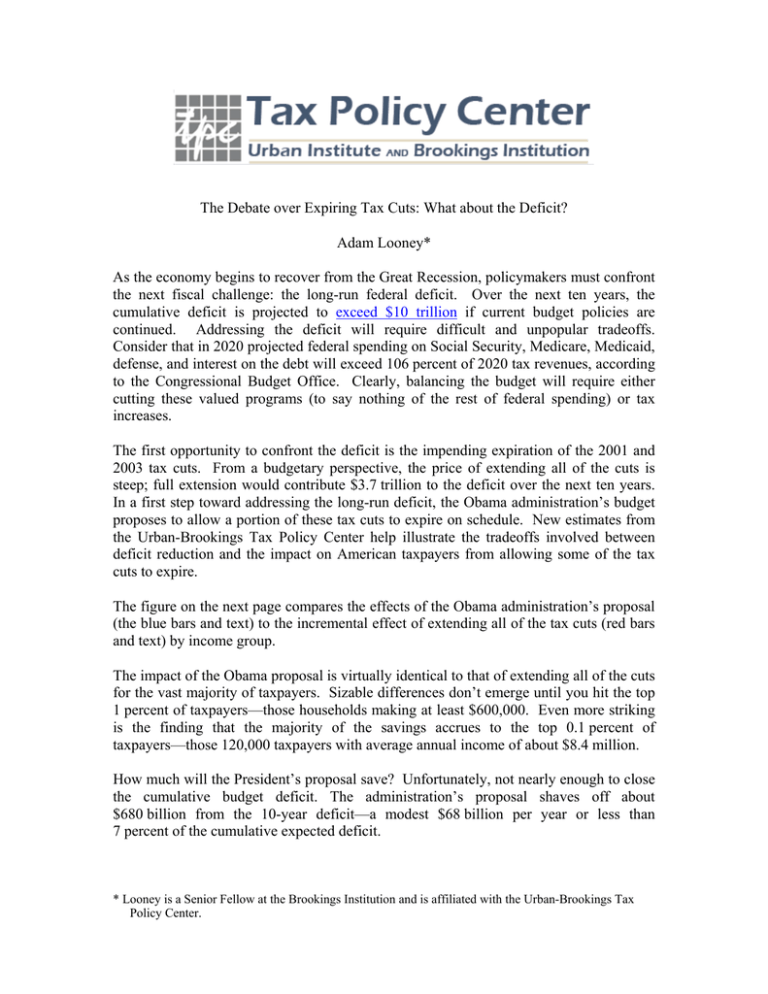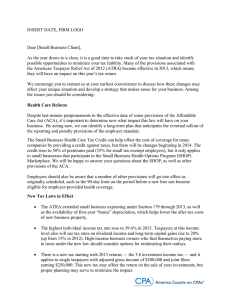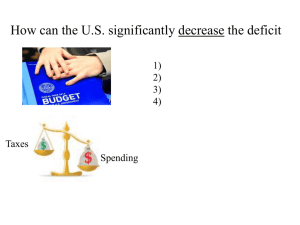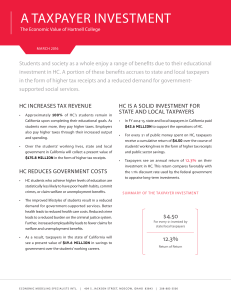The Debate over Expiring Tax Cuts: What about the Deficit?
advertisement

The Debate over Expiring Tax Cuts: What about the Deficit? Adam Looney* As the economy begins to recover from the Great Recession, policymakers must confront the next fiscal challenge: the long-run federal deficit. Over the next ten years, the cumulative deficit is projected to exceed $10 trillion if current budget policies are continued. Addressing the deficit will require difficult and unpopular tradeoffs. Consider that in 2020 projected federal spending on Social Security, Medicare, Medicaid, defense, and interest on the debt will exceed 106 percent of 2020 tax revenues, according to the Congressional Budget Office. Clearly, balancing the budget will require either cutting these valued programs (to say nothing of the rest of federal spending) or tax increases. The first opportunity to confront the deficit is the impending expiration of the 2001 and 2003 tax cuts. From a budgetary perspective, the price of extending all of the cuts is steep; full extension would contribute $3.7 trillion to the deficit over the next ten years. In a first step toward addressing the long-run deficit, the Obama administration’s budget proposes to allow a portion of these tax cuts to expire on schedule. New estimates from the Urban-Brookings Tax Policy Center help illustrate the tradeoffs involved between deficit reduction and the impact on American taxpayers from allowing some of the tax cuts to expire. The figure on the next page compares the effects of the Obama administration’s proposal (the blue bars and text) to the incremental effect of extending all of the tax cuts (red bars and text) by income group. The impact of the Obama proposal is virtually identical to that of extending all of the cuts for the vast majority of taxpayers. Sizable differences don’t emerge until you hit the top 1 percent of taxpayers—those households making at least $600,000. Even more striking is the finding that the majority of the savings accrues to the top 0.1 percent of taxpayers—those 120,000 taxpayers with average annual income of about $8.4 million. How much will the President’s proposal save? Unfortunately, not nearly enough to close the cumulative budget deficit. The administration’s proposal shaves off about $680 billion from the 10-year deficit—a modest $68 billion per year or less than 7 percent of the cumulative expected deficit. * Looney is a Senior Fellow at the Brookings Institution and is affiliated with the Urban-Brookings Tax Policy Center. Average Tax Cut by Income Group Dollars $400,000 $350,000 $300,000 $310,140 Complete Extension of 2001 and 2003 Tax Cuts $250,000 Administration Proposal $200,000 $150,000 $100,000 $25,179 $14,022 $50,000 $‐ Percentile: Average Income: $69 $583 0‐20% $11,600 20‐40% $1,016 $2,124 $4,032 $2 $5,508 $873 $8,809 $61,510 40‐60% 60‐80% 80‐90% 90‐95% 95‐99% 99‐99.9% 99.9‐100% $52,224 $138,385 $345,574 $8,367,274 $28,852 $88,978 $196,549 $1,098,290 Source: Urban‐Brookings Tax Policy Center Microsimulation Model (version 0509) In other words, the heated debate over whether to extend all of the tax cuts or whether to extend merely the vast majority largely concerns whether to extend an extra $310,000 in tax relief to the wealthiest 120,000 taxpayers or whether we should instead make a relatively small down payment toward fiscal sustainability. In this time of economic uncertainty, policymakers are wise to be concerned about how measures to address deficits might affect the fragile recovery. However, future choices will involve far more difficult tradeoffs than today’s debate of whether we can afford to send $300,000 checks every year to a narrowly concentrated group of taxpayers. Given current budget constraints, should policymakers commit to extend any of these tax cuts at all? The remainder of this paper provides additional background and analysis of the expiring provisions of the 2001 and 2003 tax cuts. Budgetary Impact According to the U.S. Department of Treasury, full renewal of the individual 2001 and 2003 tax cuts will cost an average of $366 billion each year over the next 10 years or about $3.7 trillion over the 10-year budget window. President Obama calls for extending 2 about $299 billion of the annual average aggregate tax cuts or roughly 82 percent of the total dollar cost of extending all of the tax cuts. Figure 1 divides up the total annual cost of extending all the tax cuts into its constituent provisions. The bars shaded in blue show the revenue cost of the provisions the Administration proposes to renew; the red bars the incremental cost of extending the remaining provisions. As is apparent, the two proposals have similar impacts on the budget deficit, with the administration’s proposal shaving about $68 billion a year off the budget deficit relative to the cost of fully extending all tax cuts. Figure 1: Annual Revenue Cost of Extending 2001/2003 Tax Cuts Billions of Dollars 400 Extend 33 and 35 percent Tax Rates 350 $36 300 $21 $11 $26 250 $24 $29 200 $32 Repeal PEP and Pease for upper brackets Lower Rate on Dividends and Capital Gains to 15 percent Extend Estate Tax at 2009 Levels Tax Dividends Like Capital Gains and Lower Rates for Bottom Tax Brackets Expanded Tax Credits 150 $121 Marriage Penalty Relief 100 Extend 10, 25, and 28 percent Tax Rates 50 $66 Index AMT 0 Source: U.S. Treasury The largest costs arise from extending the 10, 25, and 28 percent tax brackets (roughly $121 billion per year), followed by AMT relief ($65 billion), extension of the 33 percent and 35 percent brackets ($33 billion), and marriage penalty relief ($32 billion). These provisions generally apply to the broadest share of the taxpaying population and reduce 3 rates on the most common sources of income like wages and salaries. The provisions related to capital gains and dividends reduce revenues by a combined $34 billion—the administration’s proposal to tax dividends at the capital gains rate for all taxpayers account for about $24 billion of the total cost. Distributional Effects New estimates from the Tax Policy Center illustrate the effects of these policy alternatives on taxes paid and on the after-tax income of different income groups and allow a comparison of the effect of extending the tax cuts in full to Obama’s proposal to allow certain high-income provisions to expire. Figure 2 shows the percent change in after-tax income for households at different income levels under the president’s proposal. The change in after-tax income is a good reflection of how the tax changes affect a family’s well-being because it measures the change in their take-home pay and purchasing power. In addition, these figures provide some insight into the short-run macroeconomic effects of these tax provisions. Since households have different propensities to spend or save out of take-home pay depending on their average income—lower-income groups have a higher propensity to spend— looking at the changes in after-tax income of different groups may also help evaluate how well the extension of the tax cuts will serve as stimulus. Figure 2: Percent Change in After‐Tax Income by Income Group Percent Change 8% 5.8% 7% 6% 1.1% Complete Extension of 2001 and 2003 Tax Cuts Administration Proposal 3.3% 1.8% 5% 4% 3.9% 3.8% 3.5% 80‐90% 90‐95% 95‐99% 3.0% 3% 2.3% 2.4% 20‐40% 40‐60% 2% 1% 0.6% 0% Percentile: 0‐20% Average $11,600 Income: 60‐80% 99‐99.9% 99.9‐100% $52,224 $138,385 $345,574 $8,367,274 $28,852 $88,978 $196,549 $1,098,290 Source: Urban-Brookings Tax Policy Center Microsimulation Model (version 0509-5). 4 Overall, the two proposals are remarkably similar because the Administration’s plan extends the tax cuts in full for 98 percent of taxpayers. For the remaining 2 percent, the administration’s plan partially extends the tax cuts. Although commonly billed as “extending the tax cuts only for those making less than $250,000,” estimates from the Tax Policy Center show that the administration’s proposed extensions provide tax relief to taxpayers at all income levels. Indeed, the administration proposal reduces taxes for the same number of taxpayers—74 percent—as does extending all of the tax cuts. In fact, 95 percent of taxpayers in the top 1 percent get a tax break. Figure 2 shows that the greatest increase in after tax income under the administration proposal goes to upper-middle-class taxpayers, those in the 80th through 95th percentiles. Both the poor (those in the bottom fifth of earners) and the very rich (those in the top 1 percent) experience relatively smaller increases in after-tax income under the administration’s proposal. The two alternatives differ significantly among high-income taxpayers. Under the administration’s proposal, those in the 99th to 99.9th percentile group experience increases in after-tax income of 1.8 percent while those in the top 0.1 percent of taxpayers would see their incomes go up by 1.1 percent. The full extension of all cuts would boost the after tax income of those in the 99th to 99.9th percentile group (with average incomes of about $1,100,00 per year) by an additional 3.3 percent for a total increase of 5.1 percent, almost three times the increase under the Administration’s proposal. Extending the cuts in the top two tax brackets has the largest boost in the top income group—the after-tax income of the 120,000 taxpayers rises by an additional 5.8 percent of their take-home pay under current law. Combined with the Administration proposal, this totals to a 6.9 percent increase in the after tax income of the wealthiest 120,000 taxpayers, more than 6 times the increase under the Administration’s proposal. Figure 3 replicates this analysis in dollar terms. Under the administration’s proposal, taxpayers in the top 0.1 percent receive an average tax cut of $61,510, taxpayers between 99 percent and 99.9 percent receive tax cuts of $14,021 each, and taxpayers in the middle quintile (40 percent to 60 percent) receive a $1,017 tax break. Taxpayers in the lowest quintile receive an average tax cut of $69. Overall, despite the fact that the administration proposal specifically allows higher-income tax provisions to expire, tax cuts to the top 5 percent earners account for 25 percent of the forgone revenues in the administration proposal. For the top 1 percent, however, and particularly for the top 0.1 percent, the differences between the two proposals are striking. The taxpayers in these groups benefit from the administration’s proposals, but to a much lesser extent than if the cut are fully extended. In particular, more than 55 percent of the revenue difference between the administration’s proposal and the full extension of the tax cut accrues to the top 0.1 percent of taxpayers who receive an additional $310,000 each, for a total tax cut of more than $370,000. Those between the 99th and 99.9th percentile also receive substantial increases in the size of their tax cuts under full extension—an additional tax cut of around $25,000, for a total tax cut of around $39,000. 5 Figure 3: Average Tax Cut by Income Group Dollars $400,000 $350,000 $300,000 $310,140 Complete Extension of 2001 and 2003 Tax Cuts $250,000 Administration Proposal $200,000 $150,000 $100,000 $25,179 $14,022 $50,000 $69 $583 $1,016 $2,124 $4,032 $2 $5,508 $873 $8,809 Percentile: 0‐20% 20‐40% 40‐60% 60‐80% 80‐90% 90‐95% 95‐99% Average Income: $11,600 $‐ $61,510 99‐99.9% 99.9‐100% $52,224 $138,385 $345,574 $8,367,274 $28,852 $88,978 $196,549 $1,098,290 Source: Urban‐Brookings Tax Policy Center Microsimulation Model (version 0509) Incremental Effects of Individual Tax Provisions The 2001 and 2003 tax cuts included a number of varied and interacting provisions. Estimates from the Tax Policy Center also provide a decomposition of the proposals into individual pieces. Combined with the budget figures above, this analysis of the constituent parts provides a menu of policy options from which to choose. Figure 4 and Table 1 show, respectively, the percent increase in after-tax income and the dollar change in taxes for each individual group of expiring tax provisions. Again, the provisions in blue are those included in the administration proposal. Figure 4 shows the effect of the constituent elements of the two proposals as a percentage of after tax income. The decomposition of the two proposals into individual pieces reveals some interesting facts about the two proposals. Maintaining the 10 percent, 25 percent and 28 percent tax brackets benefits high income as well as low income taxpayers. Indeed, in dollar terms, the greatest tax break from these provisions occurs among the highest-income taxpayers. 6 Among the more progressive changes—measured in terms of their concentration among lower-income taxpayers—are the provisions enhancing tax credits such as those for children or for education. Marriage penalty relief primarily benefits upper-middle income groups, with the highest income groups receiving slightly less and low income groups receiving very little. Figure 4: Change in After Tax income by Tax Provision 8% 7% 6% 5% Extend 33 and 35 percent brackets Repeal PEP and Pease for upper brackets Lower Rate on Dividends and Capital Gains to Top 2 Brackets Estate Tax at 2009 levels Repeal PEP and Pease for lower brackets Lower Rate on Dividends and Capital Gains Not in Top 2 Brackets Expanded Tax Credits Marriage Penalty Relief Extend 10, 25, and 28 percent Tax Rates Index AMT 4% 3% 2% 1% 0% Percentile:0‐20% $11,600 20‐40% 40‐60% 60‐80% 80‐90% 90‐95% 95‐99% 99‐99.9% 99.9‐100% $52,224 $138,385 $345,574 $8,367,274 $28,852 $88,978 $196,549 $1,098,290 Source: Urban‐Brookings Tax Policy Center Microsimulation Model (version 0509‐5) Much of the tax reduction at higher income levels occurs because of the proposed changes in the taxation of capital gains and dividends. Taxing dividends at the same rate as capital gains instead of at the higher rate applied to ordinary income (included in the administration proposal) largely benefits high-income taxpayers, who get disproportionately more dividend income. For example, focusing just on the proposal to tax dividend income at the same rate as capital gains, the 95th – 99th percentiles receive an average tax cut of $1,281 per person while the middle quintile (40th through 60th percentiles) receives an average tax cut of $103 per person. The top 0.1 percentile receives an average tax cut of about $52,887. The additional cut in capital gains and dividends tax rates from 20 percent to 15 percent for the top brackets is also highly concentrated among top earners. The 99th through 99.9th percentile of taxpayers receive an average of $6,142 each, while the top 0.1 percent receive almost 20 times as much, an average of $117,483. 7 Table 1: Incremental Change in Average Tax Burden of Extending Individual Tax Provisions, by Income Percentile in 2012 (Relative to Current Law)a Income Percentile 0‐20 20‐40 40‐60 60‐80 80‐90 90‐95 95‐99 99‐99.9 99.9‐100 Index the Alternative Minimum Tax 0 1 64 408 709 1,046 2,133 353 72 Extend 10, 25, and 28 percent Bracket Rates 36 256 534 956 1,707 2,645 3,686 5,017 5,711 Maintain Marriage Penalty Relief 4 58 77 251 869 904 529 781 873 Maintain Expanded Tax Credits 25 249 250 287 283 51 15 10 4 Tax Dividends at Capital Gains Rate, Lower Rate on Dividends and Capital Gains for Lower Brackets 1 11 34 103 225 479 1,281 5,047 52,887 Repeal PEP and Pease for Lower Brackets 0 0 0 0 1 43 189 514 560 Maintain Estate Tax at 2009 levels 3 9 58 119 237 340 977 2,300 1,403 Lower Rate on Dividends/Capital Gains for Top 2 Brackets 0 0 0 0 0 2 376 6,142 117,483 Repeal PEP and Pease for Top 2 Brackets 0 0 0 0 0 2 380 6,944 52,141 b 117 12,093 140,516 Provisions in Administration Proposal Provisions Not in Administration Proposal 0 0 0 0 0 Total for Administration Proposal 69 584 1,017 2,124 4,031 5,508 8,810 14,021 61,510 Total for Extending All Cuts 69 584 1,017 2,124 4,031 5,510 9,683 39,200 371,650 Total for Provisions Not in Administration Proposal 0 0 0 0 0 2 873 25,179 310,140 Extend 33 and 35 percent Bracket Rates (2) Memo: Average Pre‐Tax Income (Pre‐Reform) 11,600 28,852 52,224 88,978 138,385 196,549 345,574 1,098,290 8,367,274 Average After‐Tax Income (Pre‐Reform) 10,998 25,307 42,648 69,658 104,217 145,932 249,962 Number of Taxpayers (1,000s) 38,450 34,947 31,868 26,646 11,720 5,734 4,655 767,313 5,388,239 1,070 120 Source: Source: Urban‐Brookings Tax Policy Center Microsimulation Model (version 0509‐5) a. Provisions were added individually in the order shown; as a result, later changes include effects of interactions among provisions. b. The administration proposal would extend the 28 percent tax bracket to include higher‐income taxpayers. Extending all tax cuts would undo that change and thus increase taxes for affected taxpayers. 8





